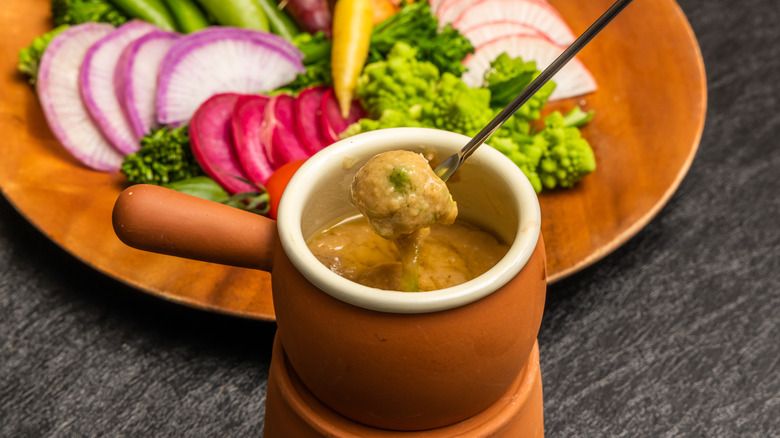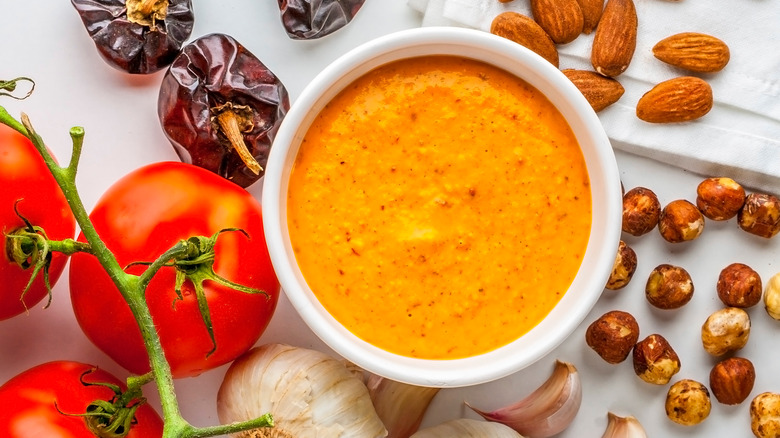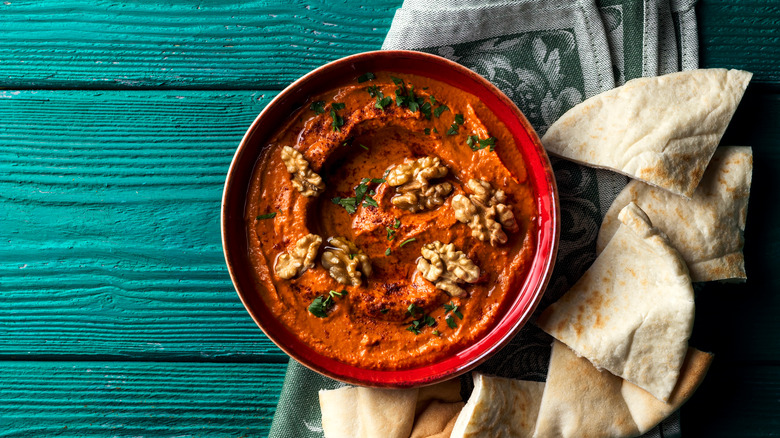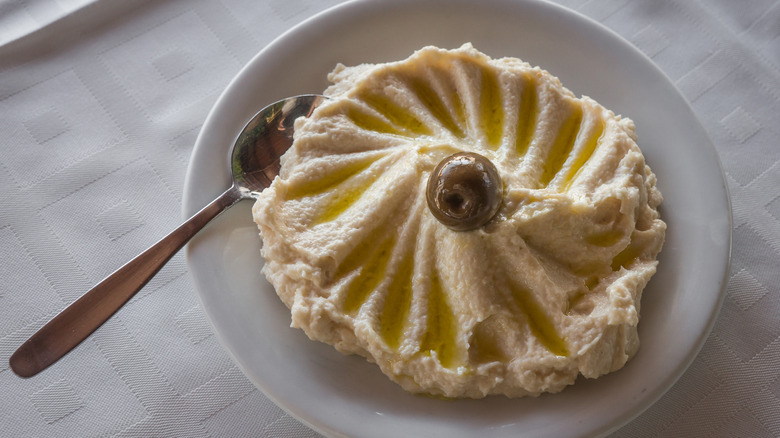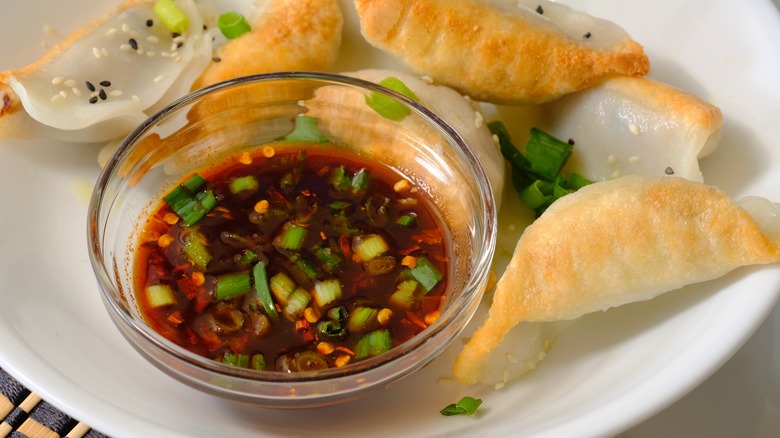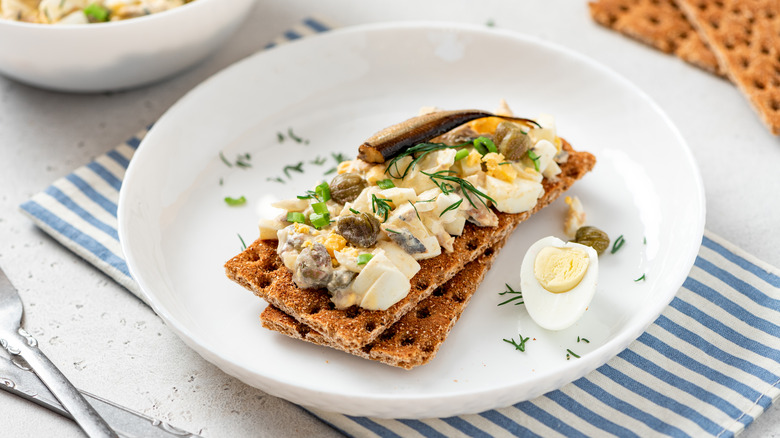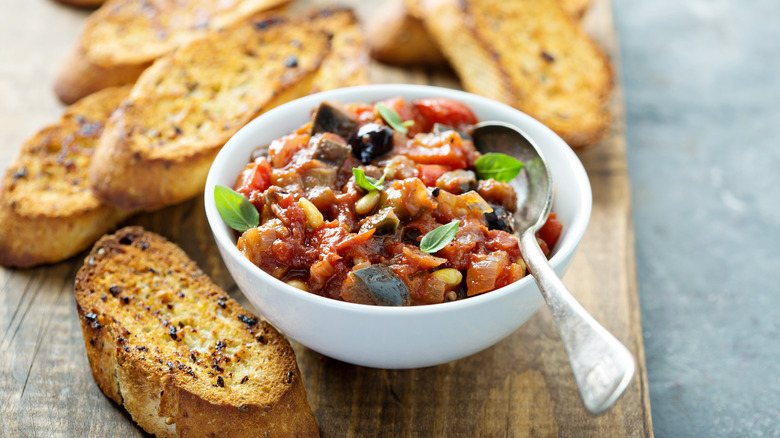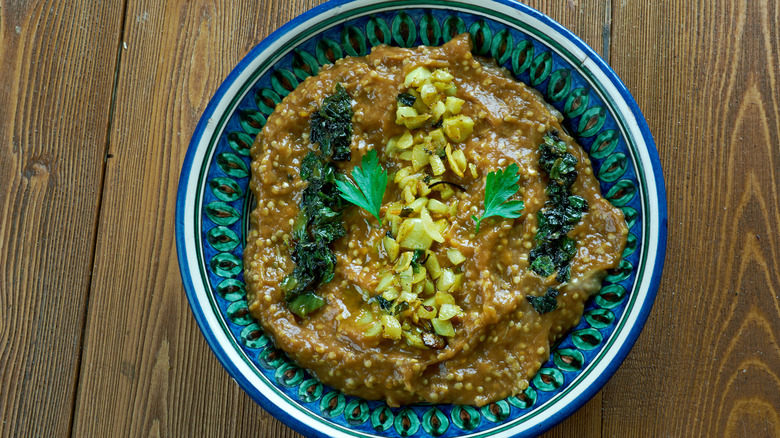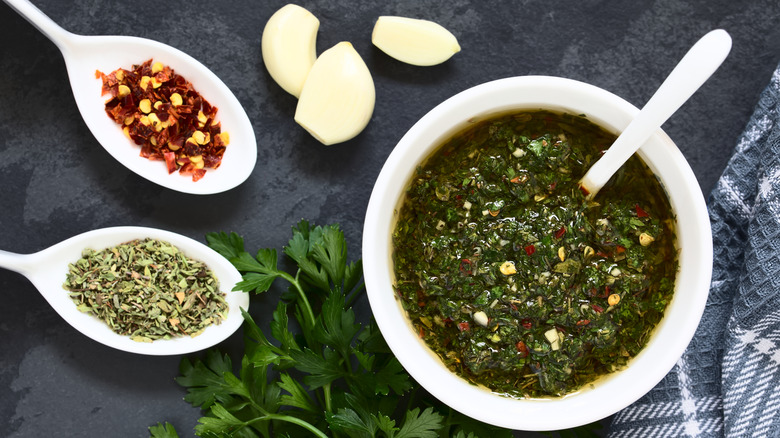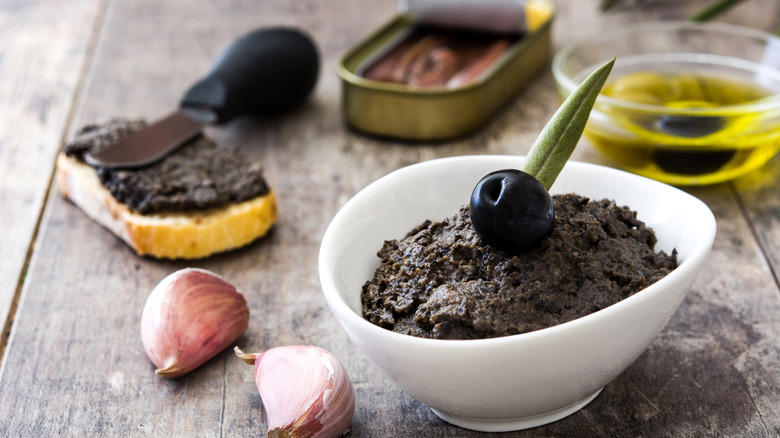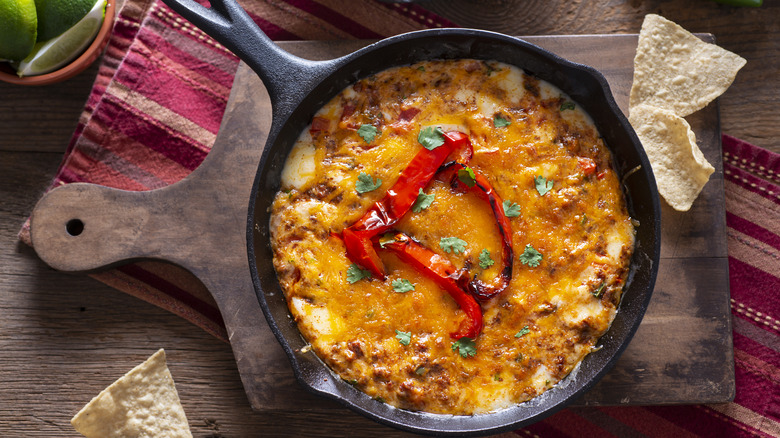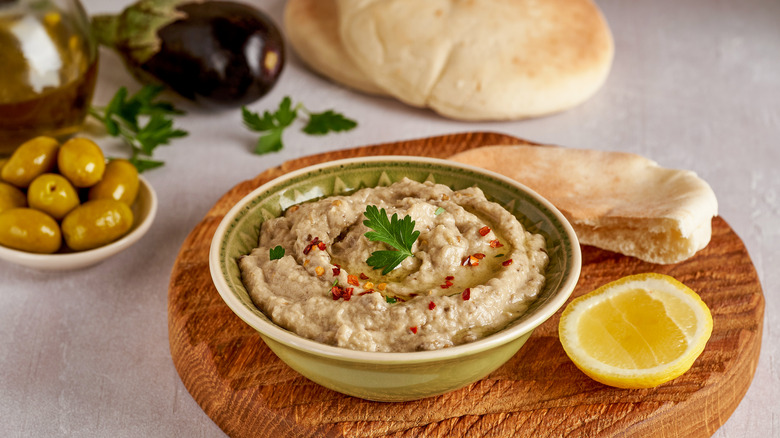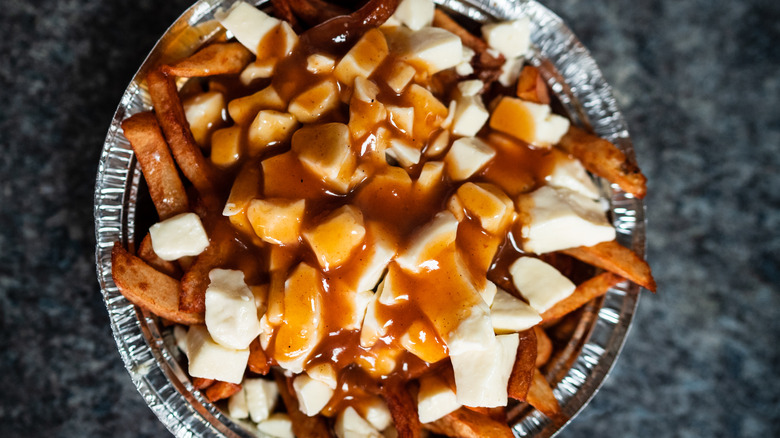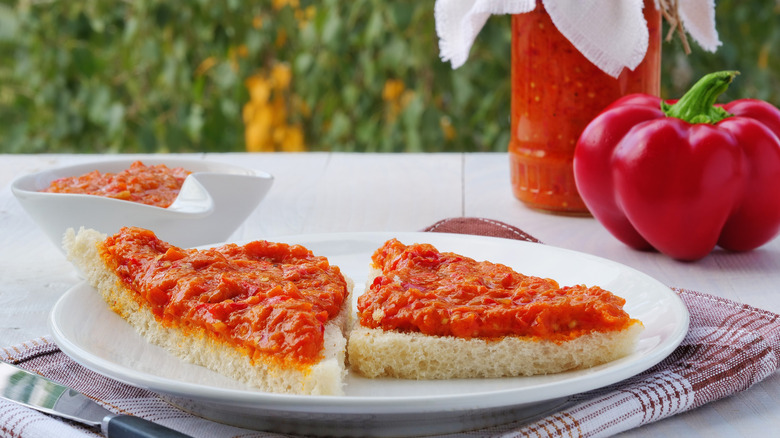15 Popular Dips From Around The World
Dips are a popular food worldwide — probably in part because this shareable food works as both an appetizer and a snack, making it useful in many different situations. Dips are excellent for social gatherings, from backyard barbecues to game nights to birthday parties.
These dishes come in many different forms. Some popular dips include sour cream and onion, spinach and artichoke, chili cheese, and seven-layer. Dips are also versatile; they can be served cold or warm, thick or thin, sweet or salty. You can eat dips with chunks of fluffy white bread, crispy tortilla chips, or crunchy carrots sticks.
Many dips enjoyed in the United States originated in other countries. Fresh guacamole was created by the Aztecs living in present-day Mexico, savory hummus was invented in the Middle East, and red marinara sauce — often enjoyed as a dip — is from Italy. But there are many other dips that you may not know. Let's explore delicious dips from around the world.
1. Bagna cauda (Italy)
Bagna cauda is an Italian dip, which roughly translates to "hot bath." This dip originated in the Piedmont region of Italy. Many food historians believe it goes back to the late Middle Ages. People enjoyed bagna cauda together around fall, when they celebrated the year's harvest.
The two main ingredients of bagna cauda are garlic and anchovies. The garlic is slowly cooked in oil and butter, and when soft, the anchovies are added. Feel free to adjust a bagna cauda recipe to your liking. Some recipes will call for a head of garlic per person, which for many diners is too much.
The savory dip is typically served hot, in a terracotta pot with a small flame, which helps keep the dip warm and melted. Raw or cooked vegetables are used as dipping vessels and thick pieces of bread are used as edible napkins to absorb anything that drips off the veggies. According to local Piedmont etiquette, bread should not be dipped in the oily dip, because it will soak up too much sauce. Diners should also avoid double-dipping.
2. Romesco (Spain)
Romesco sauce can be a dip, dressing, or spread. This smoky Spanish recipe varies, but it's usually made from a combination of roasted tomatoes, roasted red peppers, garlic, toasted nuts, and bread. The nuts and bread give the dip some texture, while the roasted tomatoes and red peppers add a smoky taste with an acidic undertone.
It's a staple in Spanish cuisine, and it's often enjoyed along with seafood, poultry, meat, and vegetables. Romesco dip is especially popular during the summer. Around this time, fresh tomatoes are abundant and grilling season is in full swing. The colorful sauce is especially excellent with crudités. But be careful not to make the mistake of confusing Romesco sauce with Romanesco — a type of Italian cauliflower.
Romesco is found throughout Spain, but it originated in Tarragona, a city in the Catalonia region. Some believe the dip is from the Roman era, but it seems unlikely because tomatoes didn't make their way to Europe until the Spanish conquest in the 16th century.
3. Muhammara (Syria)
Aleppo peppers are the star of muhammara, a dip that is originally from Syria, but is also found throughout the Middle East. This dip has roasted peppers, walnuts, breadcrumbs, olive oil, pomegranate molasses, and Aleppo pepper flakes. Muhammara can be made with raw peppers, but most agree that roasting the peppers first is the key to the flavor. Walnuts can also add more depth of flavor if they are lightly toasted first.
The recipe for this dip is flexible. Some iterations of the dip skip the Aleppo pepper because it can be challenging to find. Instead, these recipes replace the Aleppo pepper with a mixture of paprika and cayenne or a mixture of red pepper flakes, cumin, and salt. Red pepper flakes are hotter than mild Aleppo pepper flakes, so the balance of cumin serves to keep the heat down.
Muhammara tastes both smoky and sweet. The dip can have a little texture or be blended until it's completely smooth. The dip is served with pita bread, crackers, fresh veggies, or kebabs.
4. Taramasalata (Greece)
Taramasalata is a Greek dip with ancient origins, and it is widely popular throughout the country. Taramasalata is made with tarama or fish roe, usually from cod or carp. The fish roe is mixed with olive oil, lemon juice, and leftover bread or breadcrumbs. In some regions, the breadcrumbs are replaced with potatoes. In Northern Greece, they add almonds. Other regions may add scallions to the base recipe, adding a hint of tanginess, as well as texture.
Traditional taramasalata has a creamy, salty flavor that leaves a rich aftertaste. It is served with toasted bread or crackers and is especially popular during Lent. But nowadays, you can find it throughout the year in Greek restaurants.
Depending on the type of fish roe that is used, the dip can be pink or white. When taramasalata is pink, this hue comes from the artificial color added to some fish roe. Whether the dip is pink or white doesn't change the robust, briny flavor.
5. Dahl (India)
Dal is a staple in Indian cuisine. The dish starts with lentils that are cooked low and slow, creating a savory, creamy mixture. While dal is popular across India, it has many regional variations.
It can be served as dip, soup, or stew. It can be made vegan, vegetarian, or with meat. The flavor can be creamy, spicy, tangy, or earthy. Dal is a canvas of lentils. Each home chef can add their distinct touches to this canvas, using whatever herbs and spices are at their disposal. ingredients like garam masala, ginger, and cumin are commonly used, as well as others.
You can enjoy dal as a dip. Simply use classic Indian flatbreads like naan, roti, or chapati to scoop up the lentils. The savory dip with aromatic spices is a warming Indian comfort food. It would be a suitable dinner, side dish, or appetizer during colder times of the year.
6. Ponzu (Japan)
Citrusy ponzu dip is from Japan, where it's used as a popular dipping sauce for sashimi, tempura, and dumplings. The word ponzu translates to "vinegar punch," because the zesty sauce hits hard. While the sauce isn't hot like wasabi, the intensity of the vinegar and citrus is an eye-opening flavor.
Ponzu originated in Nagasaki during the Edo period. Originally, ponzu sauce was a sauce that was always made fresh at home. But by the 1960s, it was being sold and manufactured, eventually becoming a pantry staple.
This dip is made from classic Japanese pantry staples rice wine, rice vinegar, fish flakes, and seaweed. But the star of the sauce is tangy citrus. Traditionally, the dip is made with citrus fruits like yuzu and sudachi, giving it its distinct bold taste. But lemon and lime are often used instead because they are more readily available.
There are many types of ponzu sauce used throughout Japan. Some contain soy sauce, others add sesame paste. Other iterations lean into umami flavors, adding kombu dashi (soup stock made with dried seaweed).
7. Gubbrora (Sweden)
The Swedish dip gubbrora is a popular dip made with anchovies, boiled eggs, onions, sour cream, dill, chives, salt, and pepper. The name gubbrora translates to "old man's mix." The dish is a beloved Swedish staple common on buffet tables and holiday spreads.
In some versions of the dish, potatoes are added to make it more hearty. While some variations swap the anchovies for pickled herring. Gubbrora tastes like a unique egg salad with a salty finish, thanks to the briny fish. It is served on rye crackers or bread.
The anchovies used in traditional gubbrora are not the same as Mediterranean anchovies. Swedish anchovies called ansjovis are Swedish sprat filets. These have a unique spiced flavor and a firm texture. The tinned fish should be kept in the refrigerator to maintain their texture. A true gubbrora should not be mushy; both the fish and eggs should have a toothy bite.
8. Caponata (Italy)
Caponata comes from the Italian island of Sicily. It's made with a mix of Sicilian staples like eggplant, capers, olives, onions, and pine nuts. The eggplant gives the dip a meaty texture, the salty olives and capers contribute a tanginess, and the pine nuts give it a crunch.
There are many variations of caponata — Sicily has 37 versions of it. Some versions are made with red and yellow bell peppers. Other versions are made with peeled tomatoes. The small village of Polizzi Generosa adds artichokes to its caponata. In the town of Bivona, peaches, a local delicacy, are added to the sweet, savory dip. Most versions of caponata are served with slices of toasted bread as an appetizer or on grilled fish.
It's difficult to know the exact origins of caponata, but it was first mentioned in print in 1759. Most food historians agree the dish was born out of the close ties Sicily had with Arab traders, who introduced Sicily to eggplants.
9. Kashk bademjan (Iran)
The popular Persian dip kashk bademjan is made with eggplant, walnuts, and kashk — a type of fermented dairy. After the extensive fermentation process, kashk is formed into dense balls used in cooking. It is also available in liquid form. The fermented kashk adds an intense tanginess to the dip that can turn off some diners.
Some home chefs prefer to substitute kashk with Greek yogurt or sour cream, which are less intensely tangy than kashk. The dip is served topped with fried onions, mint, and curds and served with pita bread or crackers for dipping. Kashk bademjan is also good with fresh vegetables.
It's difficult to know exactly when the two main ingredients — eggplant and kashk — came together for this dip. But we do know that eggplant has been in the Middle Eastern region since ancient times. And kashk is mentioned in print in the Early Middle Ages. At some point, the two were put together to create this quintessential Persian dip.
10. Chimichurri (Argentina)
In Argentina, there is a green oily sauce called chimichurri. This sauce — which plays a central role in the cuisine — is made with parsley, cilantro, oil, chili, and garlic. Either lemon juice or vinegar is also added, providing an acidic component to the dish. Some recipes swap out the cilantro for oregano, and others add both.
The sauce has a distinct earthy taste with spicy undertones. Chimichurri is served alongside grilled meats and is also used as a dipping sauce for savory empanadas.
The exact history of chimichurri is unknown, but there are some theories that the sauce was brought to Argentina by Europeans. One theory states that an Irishman was trying to replicate Worcestershire sauce and accidentally made chimichurri. The theory is based on the man's name, Jimmy McCurry, which sounds a little bit like chimichurri. Another theory claims that European immigrants from the Basque region of Spain brought their grilling culture and grilling sauce with them when some of them immigrated to Argentina during the late 1800s. Another theory is that the sauce was always in Argentina and that it came from the Quechua people.
11. Tapenade (France)
French tapenade is a classic dip made of black olives, capers, anchovies, and olive oil. The ingredients are mashed together into a paste and served on thin slices of bread or crackers.
The French were not the first to crush olives and capers into a paste. There are writings that suggest that Romans were doing this during the first century. However, a French chef helped to popularize the dish at his restaurant during the late 19th century. His recipe — which later appeared in the classic French cookbook "La Cuisinière Provençale" – was made with anchovies, marinated tuna, capers, and other ingredients.
There are no strict rules for tapenade. It can be made with green or black olives, as well as add-ins like sun-dried tomatoes, garlic, lemon juice, cognac, and brandy. Its use in cooking has changed over time. Tapenade is now used as more than just an appetizer that is spread on toast. Tapenade is also stuffed into chicken, spread on lamb, or used as a garnish for fish.
12. Queso fundido (Mexico)
The Mexican dip queso fundido is a mix of several melted cheeses, which are heated together to form a gooey cheesy dip. The recipe can be made with any combination of different cheeses. The most common cheeses used are Oaxacan quesillo, queso asadero, queso Chihuahua, queso fresco, and Mexican manchego. Mexican manchego shouldn't be confused with Spanish Manchego. Mexican manchego is made with cow's milk and is different than Spanish Manchego, which is made with sheep's milk.
This dip is then usually topped with chorizo, grilled peppers, or mushrooms. Queso fundido is served hot, often with warm corn tortillas and fresh salsa. It is Mexican comfort food at its finest and is made to be shared.
Every household makes queso fundido a little differently, and there are many regional variations throughout Mexico. It can be topped with local chilies, dried shrimp, or machaca. In some regions, they amp it up by adding alcohol on top of the melted cheese and lighting it on fire to create queso flameado.
Queso fundido is different from Tex-Mex queso, which is made with processed cheese. Some suggest that queso fundido was the predecessor to Tex-Mex queso and packaged cheese dips.
13. Baba Ganoush (Middle East)
Baba ganoush is a creamy dip. It isn't as widely known as the other popular Middle Eastern dip, hummus, but it should be. It is just as delicious.
The dip is made from roasted, mashed eggplants, tahini, garlic, olive oil, and lemon juice. Regional variations may add cumin, parsley, or coriander. Baba ganoush is served as part of a mezze platter, which includes other dips and spreads with pita bread and vegetables. It has a smooth texture and savory, smoky taste.
It is difficult to know precisely where in the Middle East baba ganoush was first served. Many countries claim it as their own. It also has a few different origin stories. One of them comes from this dip's name. In Arabic, "baba" means father, and "ganoush" means pampered. One legend of the creamy dip is that a daughter made it for her ailing father, who did not have teeth to chew.
14. Poutine (Canada)
In the U.S., diners dip fries in ketchup; in Europe, fries get dunked in mayonnaise, but in Canada, people eat their fries as poutine. Poutine is a classic Canadian comfort food that originated in Quebec. It's made with French fries, covered in cheese curds, topped with gravy.
While poutine is technically a dish, poutine gravy is a unique sauce that's used somewhat like a dip. The brown gravy is made with chicken or beef stock, tomato paste, cornstarch, vinegar, and Worcestershire sauce. It also has more acid from the vinegar and tomato paste. Some believe the tomato paste is due to early poutine adopters adding ketchup to their poutine mix. The acid gives poutine gravy a punchier flavor than regular brown gravy.
Poutine gravy isn't just for poutine; it can be used as a dipping sauce for chicken fingers and pizza. Or you can spread it on bread for a tasty sandwich.
15. Ikra (Russia)
Ikra is a Russian dip made with eggplant, red peppers, tomatoes, onions, garlic, and oil. It's referred to in Russian as eggplant caviar, but it is purely a vegetarian dip without a drop of fish roe. It is eaten on slices of rye bread, similar to actual caviar.
The dip was one of the few things on grocery store shelves during the Soviet time, and while everyone had a jar of it in their refrigerator, it was a polarizing food. Some felt that calling the humble vegetable-based dip caviar insulted Soviet citizens. But during the 1970s, ikra became popular thanks to a Soviet film that made reference to the dip. The movie propelled the forgotten food relic to the forefront and re-popularized it.
The dip is traditionally made in the summer when fresh produce is widely available. It can be blended smooth or left a little chunky. Chefs can also add black pepper or coriander seeds to the recipe, as well.

